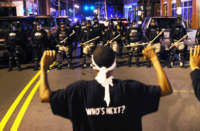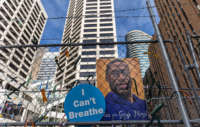
New research appears to confirm what Black Lives Matter activists and abolitionist organizers have said for years: There is a crisis of police-perpetrated killings in the United States that has gone underreported for decades, and people of color (and Black people especially) are most at risk.
Deadly police violence has long been a major public health crisis, but an estimated 17,000 deaths caused by police went missing from federal public health data over the past four decades, according to a new study published by a team of researchers in The Lancet, a leading medical journal. The study found that Black people are 3.5 times more like to be killed by police than white people, and Latinx and Indigenous people are also killed at disproportionate rates.
The study also suggests that local sheriffs, coroners, medical examiners and police themselves may play a role in skewing federal fatality data that obfuscates the severity of the police violence crisis. According to the team’s calculations, 55.5 percent of deaths caused by police were not reported as such between 1980 and 2018, including nearly 60 percent of cases where the victim was Black.
“It’s incredibly naive to assume that it is all just by happenstance, that it is just a coincidence that they are listed [under] another cause of death,” said Amara Enyia, policy and research coordinator for the Movement for Black Lives, in an interview.
The findings bolster the movement to disarm, defund and even abolish the police that grew out of the uprisings that followed the high-profile killings of unarmed Black people in recent years, from Eric Garner and Michael Brown in 2014 to George Floyd, Breonna Taylor and others in 2020.
Nationally, the study found that rates of deadly police violence and the racial disparities within them have remained stable since 1990 or increased despite reform efforts. Activists have long argued that police “reform” has never prevented police killings, and the public resources afforded to police departments should be re-invested in disadvantaged communities and public health approaches to safety.
Police violence has created simmering tensions in communities of color for decades if not centuries, but the issue often flies under the radar in the national conversation until a particularly egregious killing sparks an uprising. Along with persistent racism within the U.S. legal system and media, the new research suggests that the systematic underreporting of deaths caused by police and suppression of quality public health data may be partially to blame.
“Unfortunately, you have these headline cases that tend to put more of a spotlight on these deep systemic issues that we face, issues that there have been attempts to call attention to, but for numerous reasons they don’t gain traction until you get, for example, the murder of George Floyd or Mike Brown for any number of reasons,” Enyia said.
To conduct the study, a team of researchers compared three independent databases that track more recent police killings with the National Vital Statistics System, the federal database of births and deaths, and used data analysis to project discrepancies between the independent and government data back in time. Nonprofits and newsrooms began tracking police killings after the deaths of Brown and Garner, and journalists have noted for years the gaps between their data and what authorities report.
The study draws on previous research to explain the massive gap between the actual number of people killed by police and the number of deaths officially attributed to police violence. In many cases, a medical examiner or coroner simply fails to mention police involvement on a death certificate, or the death was incorrectly coded when entered into the federal dataset.
There are “substantial conflicts of interest” within the system for investigating and recording deaths, the authors write, including “the fact that many medical examiners and coroners work for or are embedded within police departments.” In 2011, 22 percent of respondents in a national survey of medical examiners reported that they faced pressure from an elected official or appointee to change the cause or manner of death on a death certificate.
The study also acknowledges that policing and the criminal legal system in the U.S. has a long history of anti-Black racism, and like Black revolts of the past, police at all levels of government were called to put down the uprisings and protests of 2020 by force.
“If half of the cases are going unaccounted for, that minimizes the scope and severity of police killings in this country, and I think that tracks with a lot of the narratives that came out last year that attempted to minimize the significance of George Floyd or Breonna Taylor, and reduce them to individual unfortunate cases,” Enyia said.
For example, former President Donald Trump attempted to downplay the uprisings against police last summer by claiming that more white people are killed by police than Black people. With this statement, Trump essentially manipulated data to push his preferred narrative.
A larger number of white people are killed by police because there is a larger population of white people in the U.S., but studies show that Black people are shot and killed by police at twice the rate of whites. The racial disparity is even more pronounced in cases where the victim was unarmed and posted a minimal threat to police.
“There are multiple systems at play that can perpetuate certain narratives or make sure that certain narratives don’t get the light of day, because they are in collaboration with each other is one way to put it,” Enyia said.
Enyia also noted that the manipulation of data to fit certain narratives about crime and violence has parallels in the media, where journalists often report claims made by police departments as fact without determining whether these claims are true. These narratives built on manipulated information and faulty data — including the systematic underreporting of deaths caused by police violence — directly shape public perception and policymaking.
“If those numbers are accounted for, it can change the narrative in a way that pushes for the kind of systemic changes that the Movement for Black Lives and so many other people who came out into the streets last year have been pushing for,” Enyia said.
This post was originally published on Latest – Truthout.
